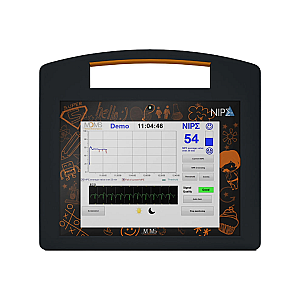The NIPE (Newborn Infant Parasympathetic Evaluation) from Mdoloris Medical Systems is a Class IIa medical device designed to continuously and non-invasively assess pain and comfort in newborns, from very premature babies (26 weeks' gestation) up to the age of 2 years. Based on the analysis of parasympathetic activity from the electrocardiogram, it provides two indices: NIPEm, for prolonged pain and overall comfort, and NIPEi, for acute pain. This objective tool helps medical teams quickly adapt care, treatment and environmental conditions to optimise the well-being of the youngest patients.
NIPE Neonatal Pain and Comfort Assessment Monitor - Brand New


Offer Details
Options :
** NEW ** 1* Mdoloris Medical Systems NIPE Monitor V1 (2020-12)
Description
NIPE: Understanding Pain where Words are not Enough
In newborns, pain is very real from the 24th week of intrauterine life, but it remains invisible without the right tools. Behavioural scales, based on observation, are useful but limited: they depend on interpretation, vary from one caregiver to another and do not allow for continuous monitoring. This is where Mdoloris Medical Systems' NIPE (Newborn Infant Parasympathetic Evaluation) comes in. Connected to the existing multi-parameter monitor, it analyses the parasympathetic activity of the autonomic nervous system from the electrocardiogram, without additional electrodes. This physiological data becomes a reliable indicator of comfort or pain, providing an objective measurement where the human eye cannot always decide.
Two Indices for Two Clinical Realities
The NIPE provides two complementary readings. The NIPEm (averaged index) reflects the overall state of comfort or prolonged pain. A score above 50 indicates satisfactory well-being; below that, it is time to adjust care, analgesia or the environment (light, noise, positioning). The NIPEi (instant index) captures the response to acute pain during a specific procedure: blood sampling, intubation, dressing change, surgical procedure, etc. At a glance, the team knows if the child is in a stressful situation and can act immediately. This dual measurement transforms care into a dynamic and responsive process focused on the child's well-being.
A Discreet but Essential Ally in Neonatal Care
In a neonatal intensive care unit, every detail counts. NIPE integrates seamlessly without disrupting practices: it uses existing ECG signals, displays data clearly on an 8-inch colour screen and operates continuously. It helps to objectively assess the beneficial effects of developmental care such as skin-to-skin contact, cocooning and sensory stimulation. In the post-operative period, it helps to precisely balance analgesia, reducing the risks associated with insufficient or excessive sedation. In the operating theatre or during prolonged monitoring, it becomes a constant reference point for limiting the impact of stress on neurological and physiological development. Compact, accurate and easy to interpret, the NIPE is not just a monitor: it is a bridge between the silent feelings of the child and the caregiver's ability to respond to them.
Features
- Objective and continuous assessment of pain and comfort
- Analysis of parasympathetic activity via ECG from the multi-parameter monitor
- No additional electrodes required
- Instantaneous and average indices to adapt care
- Optimisation of environmental conditions (light, noise, positioning)
- Adjustment of pharmacological or non-pharmacological analgesia
- Can be used in the operating theatre, intensive care and post-operative care
Technical Details
- Class IIa medical device
- Continuous, non-invasive measurement
- Comfort/pain scale from 0 to 100
- Two indices: NIPEm (prolonged pain/overall comfort) and NIPEi (acute pain)
- 8-inch colour LCD screen (200 mm) – resolution 800 x 600 px
- Dimensions: 27 x 24.7 x 14.5 cm (with collar attachment)
- Weight: 1.83 kg
- Power supply: 100-250 VAC via mains adapter
- Power consumption: 49 W (AC) / 60 W (DC)
- Operating temperature: 5°C to 35°C
- Data export: USB and Sub-D9 interface, UART protocol
Compatible Accessories
- Connection cable to the multi-parameter monitor
- Compatible power adapter
- Mounting bracket
- USB key for data export